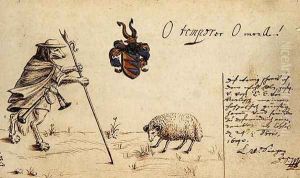Ludwig von Siegen Paintings
Ludwig von Siegen was a notable figure in the world of art, credited with the invention of the mezzotint printing process, which revolutionized the field of printmaking in the 17th century. Born in 1609 in Utrecht, Netherlands, he was a man of diverse talents and occupations, including being a soldier, courtier, and engraver. Despite his Dutch birth, much of his significant work and influence occurred within the German territories, where he spent a considerable part of his life.
Von Siegen's early life was marked by military service; he served in the armies of various German princes and the Holy Roman Emperor. His career took a significant turn when he started focusing on engraving, leading to his groundbreaking work in mezzotint. Around 1642, Ludwig von Siegen invented this new printmaking technique, which allowed for the creation of prints with subtle gradations of tone. This was a stark contrast to the more linear approaches of earlier engraving and etching techniques. His first known mezzotint print, a portrait of Amelia Elizabeth of Hesse-Kassel, demonstrates the capability of this technique to achieve a remarkable range of tonal variation, resembling the softness of chalk drawings.
Von Siegen's invention did not immediately gain widespread recognition, as he initially kept the process a secret, sharing it with only a few selected individuals. It was only later, through the efforts of Prince Rupert of the Rhine, who improved upon Siegen's technique, that mezzotint became widely known and used across Europe, particularly in England, where it gained significant popularity for reproducing the tones and textures of paintings.
Despite the revolutionary nature of his invention, little is known about the later years of Ludwig von Siegen's life. He is believed to have died in 1680. While his invention of mezzotint was his most significant contribution to the arts, the details of his personal life and other works remain largely obscure. Nevertheless, his legacy lives on through the mezzotint technique, which remains a valued method in printmaking for its unique ability to capture the nuances of light and shadow, contributing significantly to the development of graphic arts.
